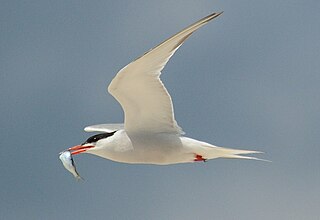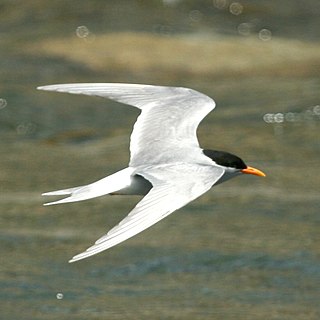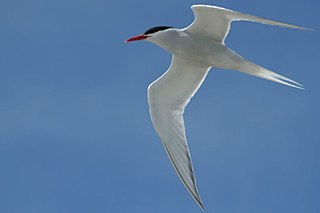
Terns are seabirds in the family Laridae that have a worldwide distribution and are normally found near the sea, rivers, or wetlands. Terns are treated as a subgroup of the family Laridae which includes gulls and skimmers and consist of eleven genera. They are slender, lightly built birds with long, forked tails, narrow wings, long bills, and relatively short legs. Most species are pale grey above and white below, with a contrasting black cap to the head, but the marsh terns, the Inca tern, and some noddies have dark plumage for at least part of the year. The sexes are identical in appearance, but young birds are readily distinguishable from adults. Terns have a non-breeding plumage, which usually involves a white forehead and much-reduced black cap.

The Arctic tern is a tern in the family Laridae. This bird has a circumpolar breeding distribution covering the Arctic and sub-Arctic regions of Europe, Asia, and North America. The species is strongly migratory, seeing two summers each year as it migrates along a convoluted route from its northern breeding grounds to the Antarctic coast for the southern summer and back again about six months later. Recent studies have shown average annual roundtrip lengths of about 70,900 km (44,100 mi) for birds nesting in Iceland and Greenland and about 90,000 km (56,000 mi) for birds nesting in the Netherlands. These are by far the longest migrations known in the animal kingdom. The Arctic tern flies as well as glides through the air. It nests once every one to three years ; once it has finished nesting it takes to the sky for another long southern migration.

The common tern is a seabird in the family Laridae. This bird has a circumpolar distribution, its four subspecies breeding in temperate and subarctic regions of Europe, Asia and North America. It is strongly migratory, wintering in coastal tropical and subtropical regions. Breeding adults have light grey upperparts, white to very light grey underparts, a black cap, orange-red legs, and a narrow pointed bill. Depending on the subspecies, the bill may be mostly red with a black tip or all black. There are a number of similar species, including the partly sympatric Arctic tern, which can be separated on plumage details, leg and bill colour, or vocalisations.

The roseate tern is a tern in the family Laridae. The genus name Sterna is derived from Old English "stearn", "tern", and the specific dougallii refers to Scottish physician and collector Dr Peter McDougall (1777–1814). "Roseate" refers to the bird's pink breast in breeding plumage.

The whiskered tern is a tern in the family Laridae. The genus name is from Ancient Greek khelidonios, "swallow-like", from khelidon, "swallow". The specific hybridus is Latin for hybrid; Pallas thought it might be a hybrid of white-winged black tern and common tern, writing "Sterna fissipes [Chlidonias leucopterus] et Hirundine [Sterna hirundo] natam”.

The Aleutian tern is a seabird in the family Laridae. The genus name is from Ancient Greek onux, "claw", and prion, "nail". The specific aleuticus refers to the Aleutian Islands.

The white-fronted tern is the most common tern of New Zealand. It rarely swims, apart from bathing, despite having webbed feet. The species is protected.

The name marsh tern refers to terns of the genus Chlidonias, which are typically found in freshwater marshes, rather than coastal locations. The genus name Chlidonias is from Ancient Greek khelidonios, "swallow-like", from khelidon, "swallow".

The black-bellied tern is a tern found near large rivers in the Indian subcontinent, its range extending from Pakistan, Nepal and India to Myanmar. It has become very scarce in the eastern part of its range and the International Union for Conservation of Nature has assessed its conservation status as being endangered.

The spectacled tern, also known as the grey-backed tern, is a seabird in the family Laridae.

Tuckernuck is an island in the town and former whaling port of Nantucket, Massachusetts, west of Nantucket Island and east of Muskeget. Its name allegedly means "a loaf of bread". The island has an area of about 900 acres. The highest point is about 50 feet.

The Antarctic tern is a typical tern. It ranges throughout the southern oceans. It is very similar in appearance to the closely related Arctic tern, but is stockier, and the wing tips are grey instead of blackish in flight. It is in breeding plumage in the southern summer, when the Arctic tern has moulted to its non-breeding plumage.

The Kerguelen tern is a tern of the southern hemisphere.

The black-fronted tern also known as sea martin, ploughboy, inland tern, riverbed tern or tarapiroe, is a small tern generally found in or near bodies of fresh water in New Zealand and forages for freshwater fish, arthropods and worms. It has a predominantly grey plumage. Restricted to breeding in the eastern regions of South Island, it is declining and threatened by introduced mammals and birds.

The South American tern is a species of tern found in coastal regions of southern South America, including the Falkland Islands, ranging north to Peru and Brazil. It is generally the most common tern in its range. The smaller, highly migratory common tern closely resembles it. The specific epithet refers to the "swallow-like" forked tail feathering.

The white-cheeked tern is a species of tern in the family Laridae.
It is found around the coasts on the Red Sea, around the Horn of Africa to Kenya, in the Persian Gulf and along the Iranian coast to Pakistan and western India.

The black-naped tern is an oceanic tern mostly found in tropical and subtropical areas of the Pacific and Indian Oceans. It is rarely found inland.

Velanidia is a village and a community of the Voio municipality. Before the 2011 local government reform it was part of the municipality of Neapoli, of which it was a municipal district. The 2011 census recorded 79 inhabitants in the village and 109 inhabitants in the community of Velanidia.

Cap Island Conservation Park is located 7.5 km offshore, west of Mount Misery, Eyre Peninsula. The park covers Cap Island's 8ha surface. The island consists of a granite base and a calcarenite mantle; its margins steeply over-hanging and eroded. Typical vegetation is a low Nitre Bush shrubland. Cap Island Conservation Park was constituted by statute in 1972 to conserve a sea bird breeding area and Australian Sea-lion and New Zealand Fur-seal haul-out areas.



















